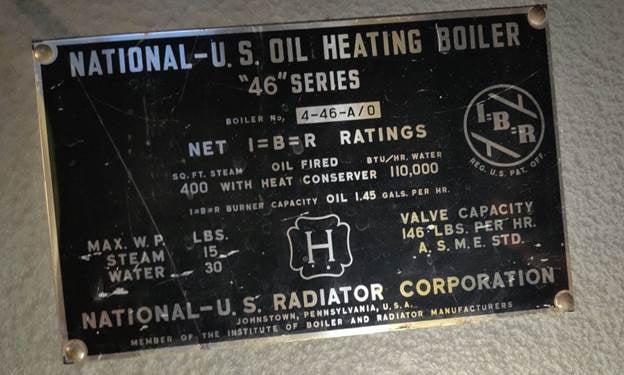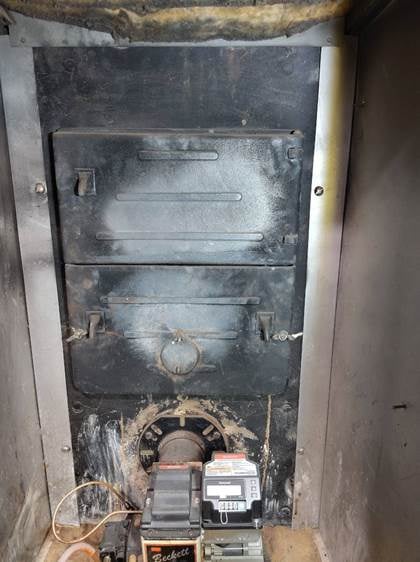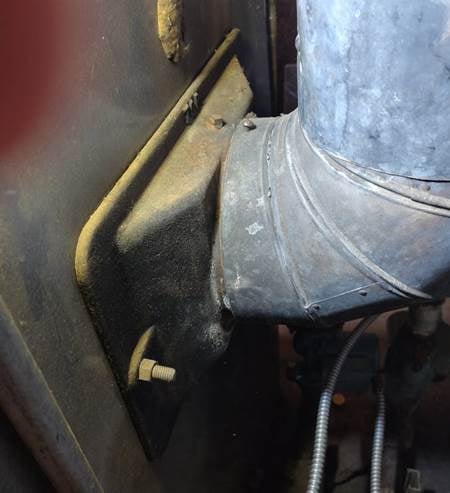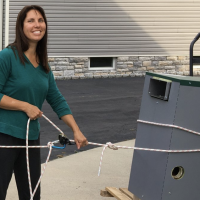Boiler ID and clean out question:
I’ve got a mid 50s vintage house, 1956 to be specific, with an original boiler I’m trying to keep alive a bit longer.
I did upgrade all the controls year or two ago and got rid of the ancient stack switch. I'm overdue for a good clean out though. I've done boiler cleanouts previously one more modern Bunham boilers but I'm a little unclear on access to this one.
I've tried looking up this boiler on the line but despite the brand being pretty popular I come up empty on any info related to this series:
There are two access doors when you remove the front panel. The lower one goes into the firebox, the upper gives you access to the heat exchange portion of the boiler.
It looks like the flue adapter comes off the back of the boiler and that you clean it out front to back:
I assume as stated that there is no access from the top. You would do everything from the front doors back through the Flue pipe adapter.
Looking to pick up clean out brush too that's why I want to see what access looks like and the appropriate size brush.
Appreciate any comments on the boiler ID also
Thanks
Dave
Comments
-
That is an older style of boiler and can be thoroughly cleaned using the two access doors on the front. The flue passages are horizontal, not vertical as in modern pin style boilers.
The design dates from the coal burning era, when the flues had to be brushed down much more frequently than they do when firing oil.
—
Bburd2 -
Thanks. The passageways are definitely not what I'm used to seeing from the Burnham boiler in my previous house. Much bigger! Looks like a 2 to 3 inch brush is required.
I'll probably pull the back off any way to check things out.
Does the info on that nameplate make sense for about 1956?
Thanks,
Dave
0 -
Yes, the nameplate is right for a mid-1950s boiler.
—
Bburd0 -
Most of the cleaning will be through the upper flue door. If you look in there with a flashlight you should be able to see the flue pipe in the back. I used to use a 2" x 3" rectangle brush but any brush will probably work if not too large. Do the top door first some soot will fall down in the fire box so you can vacuum it out after you clean through the lower door. You may want to take the flue pipe down and clean it especially if you new to the house. After that you shouldn't need to do the flue pipe every 4 years if the burner is firing right.
0 -
200,000 btu/hr in 110,000 btu/hr out?
0 -
That would have been with the original burner. With a modern flame-retention burner like that Beckett, it's probably more like 182,000 or 1.35 GPH input to get the same output.
All Steamed Up, Inc.
Towson, MD, USA
Steam, Vapor & Hot-Water Heating Specialists
Oil & Gas Burner Service
Consulting1 -
Thanks for the comments guys. Right now the house doesn't have any AC.
I'm looking at doing an AC install next year and of course incremental investment to do a full house heat pump isn't huge.
The thinking would be to just leave the oil stuff in place until I figure out whether I want go all electric or not.
Even then I would probably leave it all in place as a backup.
Dave
0 -
-
Don't even think about tearing out that boiler system. You'll want it for when it gets cold enough that the heat pump doesn't work well and uses way more electricity trying to keep up.
All Steamed Up, Inc.
Towson, MD, USA
Steam, Vapor & Hot-Water Heating Specialists
Oil & Gas Burner Service
Consulting0 -
It is sure fun to hate on heat pumps, we all love it. But we don't even know where this boiler is located, so isn't it premature to say that a heat pump would fail to heat the home?
NJ Steam Homeowner.
Free NJ and remote steam advice: https://heatinghelp.com/find-a-contractor/detail/new-jersey-steam-help/
See my sight glass boiler videos: https://bit.ly/3sZW1el0 -
House and boiler from mid 50's and a fair sized burner indicate that it is in a cold location with plenty of air exchanges.
When really cold, my guess is that the heat pump system will not be comfortable enough. IMO
0
Categories
- All Categories
- 87.3K THE MAIN WALL
- 3.2K A-C, Heat Pumps & Refrigeration
- 61 Biomass
- 427 Carbon Monoxide Awareness
- 119 Chimneys & Flues
- 2.1K Domestic Hot Water
- 5.8K Gas Heating
- 115 Geothermal
- 165 Indoor-Air Quality
- 3.7K Oil Heating
- 76 Pipe Deterioration
- 1K Plumbing
- 6.5K Radiant Heating
- 395 Solar
- 15.6K Strictly Steam
- 3.4K Thermostats and Controls
- 56 Water Quality
- 51 Industry Classes
- 49 Job Opportunities
- 18 Recall Announcements






